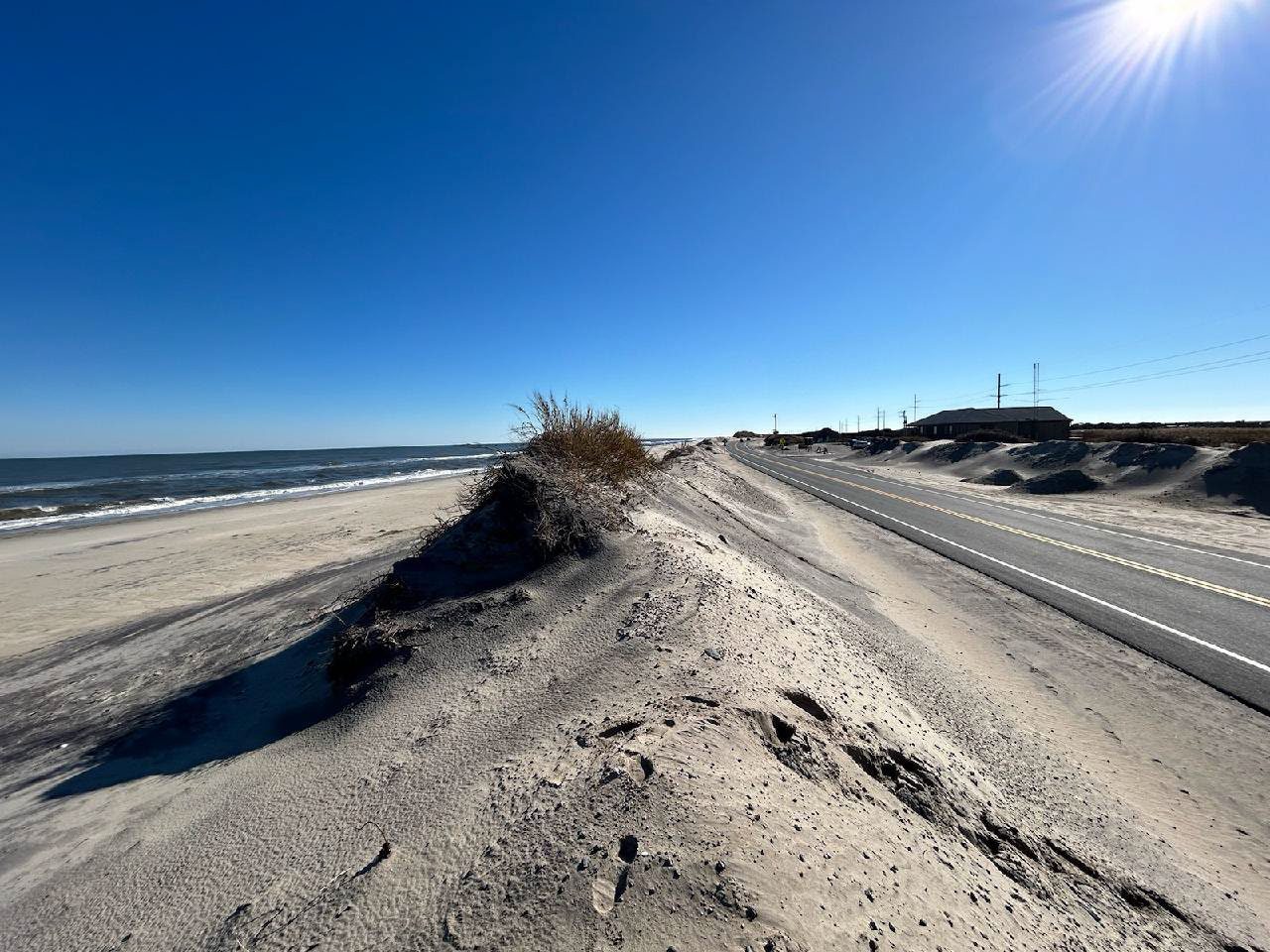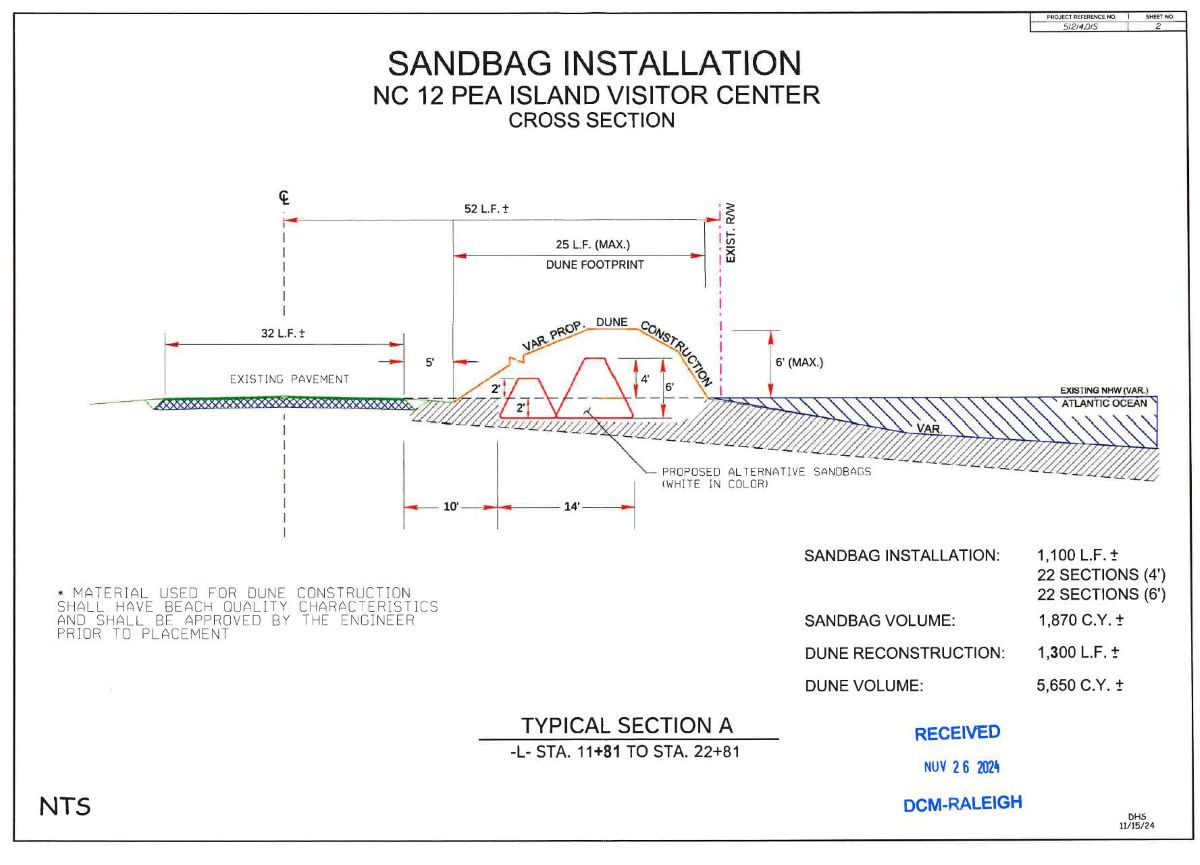
The North Carolina Department of Transportation can begin work on a temporary solution to protect a stretch of N.C. Highway 12 in Rodanthe that frequently experiences overwash, coastal flooding and erosion — but NCDOT officials are looking for a more permanent fix.
Earlier this week, the Coastal Resources Commission unanimously approved NCDOT’s variance request to repair 1,300 feet of primary sand dune and install 1,100 feet of sandbags on the oceanside right-of-way near the visitor center for the Pea Island National Wildlife Refuge. A variance, once granted, allows coastal development that would otherwise be prohibited by commission rules.
Supporter Spotlight
“We hope to start the project sometime in mid-January, and it will take roughly one week to complete,” NCDOT Communications Officer Tim Hass told Coastal Review Tuesday. He said that during the project, which should cost about $400,000, there will be temporary single-lane closures in the area on N.C. Highway 12.
After a storm last month forced transportation officials to close N.C. 12 near the refuge’s visitor center, NCDOT submitted to Division of Coastal Management staff on Nov. 24 a request to modify the existing Coastal Area Management Act permit issued in 1999 that allows for maintenance work along the Outer Banks highway.
The division is under the North Carolina Department of Environmental Quality and acts as staff to the commission. Division staff make permit decisions based on commission rules.
Division staff on Dec. 4 issued a modification to NCDOT’s existing CAMA major permit but “conditioned out those aspects of the proposed sandbag structure which did not meet the Commission’s Rules, including the size and color of the sandbags, the size of the sandbag structure, and the impacts to existing dunes,” documents state.
If the division denies a permit request because the proposed project is outside of development rules, the petitioner can request a variance from the commission to allow the work, which is what NCDOT did, leading to the special-called meeting held Monday morning by web conference.
Supporter Spotlight
NCDEQ Assistant General Counsel Christy Goebel explained that NCDOT owns and maintains the public right-of-way easement through Pea Island National Wildlife Refuge on Hatteras Island in Dare County.
“As we know, N.C. 12 provides the only roadway connection between the mainland and Hatteras Island. Beach erosion, dune loss and risk to Highway 12 have been particularly severe near the refuge visitor center,” she said.
The area has been identified as a “hot spot” since at least 2002 and is characterized by low topography and low elevations. The 2020 average annual erosion rate at the visitor center hot spot is 7.5 feet per a year, and the total width of the island there is between 3,500 and 5,800 feet, though much of that area is the refuge ponds. The space between the ocean and refuge ponds that N.C. 12 passes through is as narrow as 245 feet.
“Because of storm and tidal events, and the geomorphology of this area, the hot spot is susceptible to shoreline erosion, overwash, coastal flooding, the loss of beach and dunes, and sand cover. These circumstances can undermine the integrity of the road, making travel by the general public unsafe and forcing DOT to close the road,” Goebel said.
The Nov. 15-17 storm that severely damaged the primary dune along N.C. 12 by the refuge’s visitor center prompted NCDOT’s move to put in the temporary sandbag structure.
Goebel said that ocean overwash removed around 1,000 linear feet of dune, exposing the highway’s pavement edge to the high surf. Roadway flooding and pavement drop-off produced hazardous traffic conditions, and NCDOT temporarily closed the road to all traffic. NCDOT temporarily rebuilt the primary dune as maintenance work after the storm, under the existing CAMA permit.
Goebel said that NCDOT proposed using temporary sandbags for the project that would be white, trapezoid-shaped, woven polypropylene, an alternative to the traditional tan sandbags. Plans call for the sandbags to be placed in two adjoining rows parallel to the seashore.
The row closest to the ocean would be 6 feet high with an 8-foot base, and the row closest to land would be 4-foot high with a 6-foot base. The rows will be adjacent to each other and have a combined base of 14 feet. Both rows will be placed 2 feet below the roadway and 10 feet away from the pavement.
NCDOT plans to bring in sand to fill the sandbags and cover the sandbags after they are installed with a 6-foot-high and 20-foot-wide dune. “Sand would not be dredged from the swash zone on the beach, and there would be no wetland impacts,” Goebel said.
About 950 square feet of the protective dune will extend below the normal high-water line, as well.
Existing rules require the sandbags be tan, between 3 and 5 feet wide and 7 to 15 feet long when measured flat, with a base width no wider than 20 feet and total height no more than 6 feet. Rules also dictate that no primary dunes can be removed or located, and no part of the dune should be placed below normal high water line.
This type of sandbag has been granted variances twice before. The commission allowed for this type of sandbag to be used at the north end of Ocracoke Island, but that project didn’t come to fruition because of funding, and again in February 2022, for the north end of Rodanthe, she said.

Goebel said that division staff agrees with NCDOT “that construction of the sandbag structure and the dune and the use of the alternative bags will secure public safety and welfare, and it will preserve substantial justice as it will allow the petitioner to protect 12 in the short and midterm with alternative sandbags, while continuing to work towards a long-term solution for transportation along Hatteras Island.”
Special Deputy Attorney General Colin Justice reiterated to the commission that NCDOT officials believe there are benefits to using the alternative sandbags.
Justice, who represents NCDOT and works for the North Carolina Department of Justice, said officials believe these sandbags will be more durable. Installation will happen faster than traditional sandbags and cause less of an impact because of the way the bags are filled from the top. No hydraulic pump across the beach to fill traditional sandbags is necessary.
“We think that applying the rule strictly would prevent NCDOT from being able to do this repair as effectively, as quickly and for minimizing impacts the setback requirements,” he said.
The Division of Coastal Management’s NCDOT Project Coordinator Stephen Lane said Monday that NCDOT is looking at long-term solutions for the hot spot, and has obtained funds to study “long-term comprehensive solutions to try to keep Highway 12 open for the future,” he said.
Lane is referring to the $1.8 million grant announced earlier this year to study the 11-mile stretch of N.C. 12 between Oregon Inlet and Rodanthe on Pea Island. “The project will identify future construction projects, streamline environmental reviews, include public engagement and establish detailed, long-term plans for keeping the roadway passable during and following major storm events,” officials said in the at the time.
NCDOT Division 1 Engineer Win Bridgers states in the permit modification request dated Nov. 24 that the sandbag project is a temporary solution for maintaining N.C. 12 on the Pea Island refuge.
“NCDOT has recently been awarded a PROTECT Planning Grant from (Federal Highway Administration) to conduct a Planning and Environmental Linkages (PEL) study that includes comprehensive resiliency planning, alternatives development and evaluation, and robust public engagement for NC 12 on Pea Island,” Bridgers wrote. “Also known as Solving Access for NC 12 in Dare County (SAND), this project will establish a solid foundation for future project development and construction, with the goal of streamlining subsequent environmental review, accelerating project delivery, and securing the long-term resiliency of NC 12.”
He said that NCDOT anticipations the SAND project will determine short-term and long-term solutions for maintaining N.C. 12 on Pea Island National Wildlife Refuge.
“When those solutions are implemented, NCDOT would remove the temporary sandbags when no longer needed to protect the roadway of NC 12. With the stronger material and design, the Permashield bags can be more effectively removed when they are no longer needed. NCDOT anticipates quicker and more complete removal of Permashield sandbags as opposed to the challenging removal of traditional sandbags,” Bridgers said.








